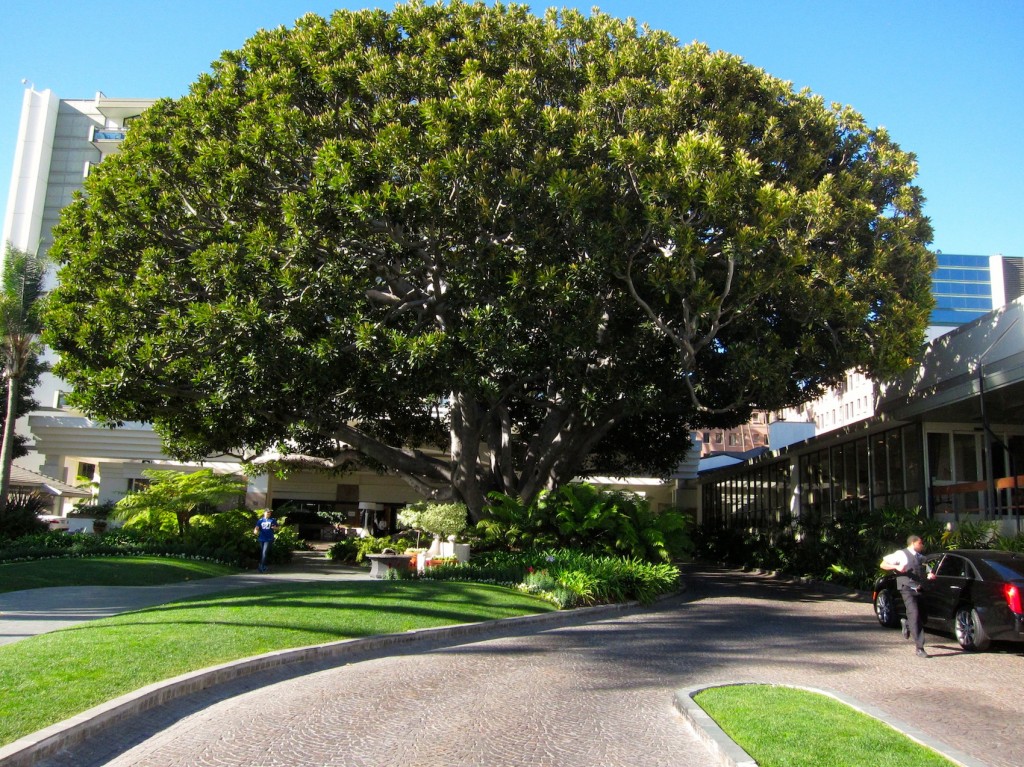
If a tree falls in Santa Monica, there will definitely be a sound, most likely one of protest. This community cares deeply about its trees, and passions run high whenever anyone tries to mess with one.
Before there are cries of “Timber!” in Santa Monica, there are many howls of “Not so fast!”
This is a town that gives the term “Tree Hugger” a good name. There’s even an annual “Tree Hugging Day” on the spring equinox where festive crowds gather to, well, hug a tree.
But it’s not always good vibes. Bad feelings surfaced in 2007 over a plan to chop down 54 downtown ficus trees that city officials said were diseased and damaging sidewalks.
That sparked noisy dissent and a court battle between the city and ardent tree supporters. Ultimately, some of the trees were spared the axe, and a community advisory board, the Urban Forest Task Force, was established to advocate for the city’s leafy assets.
Santa Monica values its trees—literally. The city’s Public Landscape Division says that trees provide close to $2 million each year in financial benefits ranging from boosting property values to savings on energy costs by providing shade.
And you thought trees were just nice to look at. Or climb on.
In the past 20 years the city has planted more than 7,000 trees, according to the Landscape Division’s urban forest website. The city has close to 34,000 trees, ranging from the Canary island pine to the laurel fig, and the jacaranda to the lemon bottlebrush.
In addition to being urban eye candy, some trees have achieved landmark status, including these three:

- The stately and lush Moreton Bay fig tree that lords over the entrance to the Fairmont Miramar Hotel at 1133 Ocean Avenue. Hotel owners could not have designed a more majestic structure than the one nature produced. The tree sprouts from its own grassy island amid hustling valets who park cars of incoming guests. Its roots reach out in all directions like massive spider legs. The tree was planted in 1879 when the grounds were the private mansion of John P. Jones, a former U.S. senator. This may be the second largest Moreton Bay fig tree in the United States, second to one in Santa Barbara.
- A Deodor cedar tree in the front yard of a private residence at 918 Fifth Street. The tree was in jeopardy in 2001 when the property’s longtime owner died and the site was being sold for development, but—you guessed it—residents rallied around the tree. It was given landmark status in 2002. The tree is more than a 105 years old and looks its age, with missing limbs and a severely thinned canopy.

- A eucalyptus tree with a unique double-trunk in the front yard of a private residence at 1407 Hill Street in the Ocean Park neighborhood. Arborists believe that the tree may have been planted at random by seeds blowing in the wind. The tree is a marvelous combination of regal stature and chaotic branch structure. It looks extremely healthy for its age, estimated to be close to 100 years.
A fourth landmarked tree, a towering, 100-year-old eucalyptus that soared to 130 feet, was cut down in 2012 despite its protected status. That’s because city officials felt that it posed a safety threat after one of its branches crashed down on a parked car. Some of this tree’s branches weighed up to one ton.

As you might expect, that tree, on 24th Street north of Montana Avenue in a residential front yard, didn’t come down without a fight. But after the city threatened the homeowner with daily fines totaling $25,000, it was reduced to a giant stump.
There are plenty of other special trees in the city. If any is threatened, rest assured a host of people will rise to its defense, landmark status or not.
